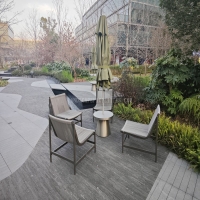Welcome to the website for landscape facilities products and knowledge.
How do landscape bar counters perform in high-wind areas, and what design modifications are needed?
Landscape bar counters, a coveted feature in modern outdoor living, face significant challenges in high-wind areas. Their performance is not merely about aesthetics but fundamentally about structural integrity and safety. Standard designs often fail, leading to catastrophic damage or becoming dangerous projectiles. However, with precise design modifications, these elegant structures can be engineered to thrive even in the most demanding windy climates, from coastal regions to mountainous terrains.
The primary vulnerability of a landscape bar counter in high winds is its large, flat surface area. The countertop and any solid side panels act as sails, catching the wind and generating immense lift and shear forces. This can lead to overturning, sliding, or complete structural failure. The key to mitigation lies not in fighting the wind, but in managing its force through intelligent design.
Several critical design modifications are non-negotiable for high-wind performance. Firstly, material selection shifts from heavy, brittle stones like granite to lighter, more flexible options. Solid surface materials, engineered quartz with a flexible substrate, or perforated metal panels are superior choices as they reduce overall weight and wind load.
The structural framework is paramount. A flimsy wooden or thin aluminum frame is insufficient. The design must incorporate a heavy-duty, corrosion-resistant aluminum or powder-coated steel frame. The connection points must be reinforced with gussets and heavy-duty brackets, moving beyond simple screws to welded joints or through-bolts to create a rigid, unified structure.
Anchoring is arguably the most crucial element. Freestanding counters are a liability. The design must integrate a permanent anchoring system directly into a permanent foundation. This typically involves installing deep concrete footings below the frost line, into which the bar counter's structural posts are embedded or bolted using seismic or hurricane-grade post bases. For installations on existing concrete slabs, core drilling and installing expanding wedge anchors or epoxy-set threaded rods provide the necessary resistance to uplift.
Aerodynamic design principles can dramatically reduce wind load. Instead of solid windbreaks, incorporating slatted or louvered side panels allows wind to pass through, dissipating energy. Similarly, opting for a cantilevered design where possible can minimize elements for the wind to catch underneath. Integrating the bar counter into a larger sheltered structure, like a pergola with a wind-rated roof, offers additional protection.
Finally, specifying wind-rated components is essential. This includes choosing an outdoor-rated countertop material that can flex slightly without cracking and securing all elements, such as drawers, cabinets, and accessories, with positive latching mechanisms to prevent them from blowing open or away.
In conclusion, a landscape bar counter in a high-wind area is a feat of engineering, not just craftsmanship. Success hinges on a holistic approach: selecting appropriate lightweight and flexible materials, constructing a robust and rigid frame, implementing a deeply anchored foundation, and employing aerodynamic strategies to minimize wind force. Consulting with a structural engineer familiar with local wind load requirements is imperative to ensure the design is not only beautiful but fundamentally safe and built to last.
Related search:

Recommendation
Metal structure rattan chair without armrests for single person, with woven seat and backrest.